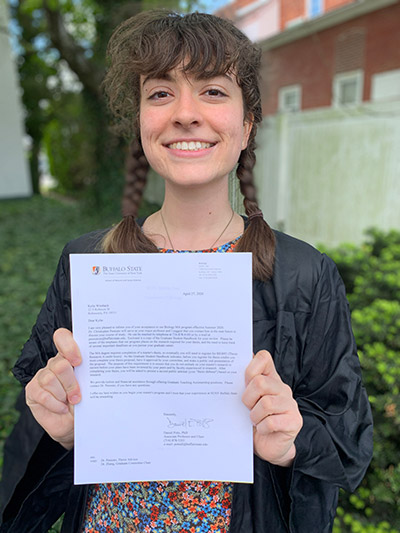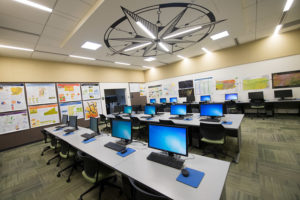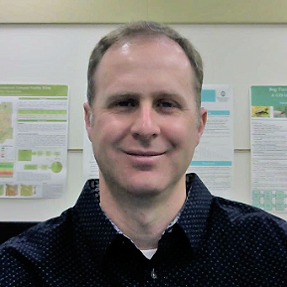From Carr Hall to the BBC: Allegheny College Student-Faculty Research Featured on International Stage
Kylie Wirebach’s research while an Allegheny College student transported her to forests near campus, the heights of the Rocky Mountains in Colorado, and, now, to the international stage of the British Broadcasting Corp.

Wirebach, Allegheny Class of 2020, was interviewed for the BBC Future story “The Return of Europe’s Largest Beasts,” published in September. She provided insights to journalist Jessica Bateman about the viability of land in central and eastern Europe for supporting bison herds.
Bateman reached out to Wirebach after learning of an article in the International Journal of Geographical Information Science by Wirebach and fellow Allegheny researchers.
“It was pretty out-of-the-blue for us,” Wirebach said of the interview request. “(Bateman) said she was writing an article about the reintroduction of the European bison in Germany specifically and saw that our recent paper included Germany in our analysis.”
That paper, “Reintroduction of the European Bison (Bison bonasus) in Central-Eastern Europe: a Case Study,” was co-authored by Wirebach; Cathlin Lord, Class of 2020; Jennifer Tompkins, Class of 2018; environmental science and sustainability professor Casey Bradshaw-Wilson, and Geographic Information Systems (GIS) instructor/lab manager Christopher Shaffer.
The article’s research began with a project by Lord, Tompkins, and Wirebach in a Conservation GIS class co-taught by Bradshaw-Wilson and Shaffer. Working in teams, students chose a species of concern somewhere in the world, finding potential real-world areas where the species could be reintroduced.
“Jenny (Tompkins) pitched the idea (of European bison) because she had learned about the large mammal’s troubled conservation history while she was studying abroad in Europe,” said Wirebach, who double majored in biology and environmental science.

Thanks to intensive management, European bison are making a comeback after nearly going extinct in the 1900s, Wirebach added. Using GIS “smart mapping” techniques that integrate many types of data, the researchers identified regions large enough to accommodate a new herd. That’s important because the bison can serve as “ecosystem engineers” in swaths of rural (formerly agricultural) areas in Europe being reclaimed by nature, Wirebach said.
But the end of the Conservation GIS class was just the beginning of the project’s reach. Lord, Tompkins, and Wirebach subsequently presented their findings at several conferences, including the Esri User Conference that gathers leading GIS professionals. Working with Bradshaw-Wilson and Shaffer as coauthors, the students published the article in the peer-reviewed International Journal of Geographical Information Science.

Shaffer, who also participated in the BBC interview, worked with Lord, Tompkins, and Wirebach in their roles as GIS teaching and research assistants. “I couldn’t ask for better students,” Shaffer said. “They helped me tremendously by answering questions from students and assisting other faculty with research projects that involved GIS and mapping approaches.”
Shaffer said that the GIS Laboratory in Carr Hall is used by academic departments across the Allegheny campus, including biology, environmental science, geology, and political science. “We need some sort of technology to help us think about the world around us,” he said. “It just makes perfect sense to integrate that technology into research questions.”
Wirebach said her research and GIS experience at Allegheny helped her to secure a graduate assistantship at SUNY Buffalo State College, where she is pursuing a master’s degree in biology. She is focusing her research on ecology and biogeography.
“Almost every (Allegheny environmental science) class I took involved a real project with a real stakeholder in the Meadville community, including the Foundation for Sustainable Forests, the French Creek Valley Conservancy, the Erie Green New Deal Coalition, and others,” she said. “As students, we often had a hand in designing the key aspects of the project, collecting the data or crafting the product, and then writing about the process for a report at the end.”
Wirebach also participated in the National Science Foundation Research Experience for Undergraduates (REU) Program, conducting research at the Rocky Mountain Biological Laboratory. That experience led to her Senior Project at Allegheny, “Mapping the potential paths for the range shifts of Colorado caddisflies (Trichoptera) under climate change.”
Like the project that led to the BBC interview, Wirebach’s thesis at Buffalo State is focused on habitat suitability analysis for reintroduction. This time, she is using GIS and historical records to investigate the availability of suitable habitat for lake sturgeon in the tributaries of Lake Erie.
“Now that I’m in graduate school, I often reflect with relief on how well Allegheny prepared me for it,” Wirebach said.